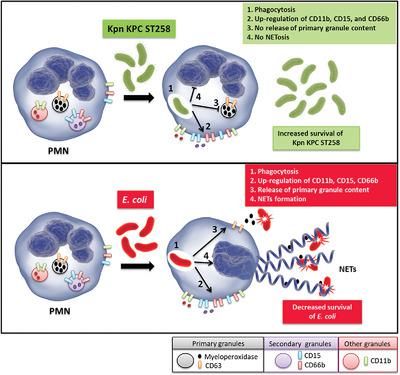当前位置:
X-MOL 学术
›
J. Leukoc. Biol.
›
论文详情
Our official English website, www.x-mol.net, welcomes your
feedback! (Note: you will need to create a separate account there.)
Modulation of neutrophil extracellular traps release by Klebsiella pneumoniae.
Journal of Leukocyte Biology ( IF 3.6 ) Pub Date : 2020-07-08 , DOI: 10.1002/jlb.4ma0620-099r Federico Birnberg-Weiss 1 , Luis A Castillo 1 , Jose R Pittaluga 1 , Daiana Martire-Greco 1 , Sonia A Gómez 2 , Verónica I Landoni 1 , Gabriela C Fernández 1
Journal of Leukocyte Biology ( IF 3.6 ) Pub Date : 2020-07-08 , DOI: 10.1002/jlb.4ma0620-099r Federico Birnberg-Weiss 1 , Luis A Castillo 1 , Jose R Pittaluga 1 , Daiana Martire-Greco 1 , Sonia A Gómez 2 , Verónica I Landoni 1 , Gabriela C Fernández 1
Affiliation

|
One of the main bactericidal mechanisms of polymorphonuclear neutrophils (PMN) is the release of neutrophil extracellular traps (NETs), which capture and destroy pathogens. Klebsiella pneumoniae (Kpn) producer of carbapenemase (KPC) and belonging to the sequence type 258 (ST258), is a hyper epidemic clone that causes a large number of infections worldwide associated with high persistence and mortality. It is necessary to investigate the interaction of Kpn KPC with the immune system to improve prevention and treatment of infections mediated by this bacterium. Based on the hypothesis that Kpn is able to subvert PMN‐mediated death, the aim was to assess whether Kpn KPC ST258 could modulate the bactericidal response of PMN, focusing on NETs formation, compared to another opportunistic pathogen, as Escherichia coli (Eco). The results showed that the release of NETs was absent when PMN were challenged with Kpn KPC, while Eco was a strong inducer of NETosis. Moreover, Kpn KPC was able to inhibit NETosis induced by Eco. The inhibition of Kpn KPC‐mediated NETs formation still occurred in spite of exogenous addition of hydrogen peroxide (H2O2), did not involve bacterial‐released soluble factors or cell wall components, and was dependent on bacterial viability. Moreover, when degranulation was investigated, we found that Kpn KPC affected only the mobilization of primary granules, which harbor the proteins with more potent bactericidal properties and those related to NETosis. In conclusion, Kpn KPC ST258 effectively managed to evade the PMN response by inhibiting the release of NETs, and primary granule mobilization.
中文翻译:

肺炎克雷伯氏菌释放中性粒细胞胞外陷阱的调节。
多形核中性粒细胞(PMN)的主要杀菌机制之一是释放中性粒细胞胞外捕获物(NETs),捕获并破坏病原体。碳青霉烯酶(KPC)的肺炎克雷伯氏菌(Kpn)生产商,属于序列类型258(ST258),是一种高流行性克隆,在世界范围内引起大量感染,与高持久性和高死亡率有关。有必要研究Kpn KPC与免疫系统的相互作用,以改善对这种细菌介导的感染的预防和治疗。基于Kpn能够颠覆PMN介导的死亡的假设,目的是评估Kpn KPC ST258是否可以调节PMN的杀菌反应,与其他机会性病原体相比,侧重于NETs的形成。大肠杆菌(Eco)。结果表明,当用Kpn KPC攻击PMN时,NETs的释放不存在,而Eco是NETosis的强诱导剂。此外,Kpn KPC能够抑制Eco引起的NETosis。尽管外源添加过氧化氢(H 2 O 2),但仍抑制了Kpn KPC介导的NETs的形成。),不涉及细菌释放的可溶性因子或细胞壁成分,并且取决于细菌的生存力。此外,在研究脱粒过程时,我们发现Kpn KPC仅影响初级颗粒的动员,初级颗粒具有具有更强杀菌特性的蛋白质以及与NETosis相关的蛋白质。总之,Kpn KPC ST258通过抑制NETs的释放和初级颗粒动员,有效地规避了PMN反应。
更新日期:2020-07-08
中文翻译:

肺炎克雷伯氏菌释放中性粒细胞胞外陷阱的调节。
多形核中性粒细胞(PMN)的主要杀菌机制之一是释放中性粒细胞胞外捕获物(NETs),捕获并破坏病原体。碳青霉烯酶(KPC)的肺炎克雷伯氏菌(Kpn)生产商,属于序列类型258(ST258),是一种高流行性克隆,在世界范围内引起大量感染,与高持久性和高死亡率有关。有必要研究Kpn KPC与免疫系统的相互作用,以改善对这种细菌介导的感染的预防和治疗。基于Kpn能够颠覆PMN介导的死亡的假设,目的是评估Kpn KPC ST258是否可以调节PMN的杀菌反应,与其他机会性病原体相比,侧重于NETs的形成。大肠杆菌(Eco)。结果表明,当用Kpn KPC攻击PMN时,NETs的释放不存在,而Eco是NETosis的强诱导剂。此外,Kpn KPC能够抑制Eco引起的NETosis。尽管外源添加过氧化氢(H 2 O 2),但仍抑制了Kpn KPC介导的NETs的形成。),不涉及细菌释放的可溶性因子或细胞壁成分,并且取决于细菌的生存力。此外,在研究脱粒过程时,我们发现Kpn KPC仅影响初级颗粒的动员,初级颗粒具有具有更强杀菌特性的蛋白质以及与NETosis相关的蛋白质。总之,Kpn KPC ST258通过抑制NETs的释放和初级颗粒动员,有效地规避了PMN反应。











































 京公网安备 11010802027423号
京公网安备 11010802027423号